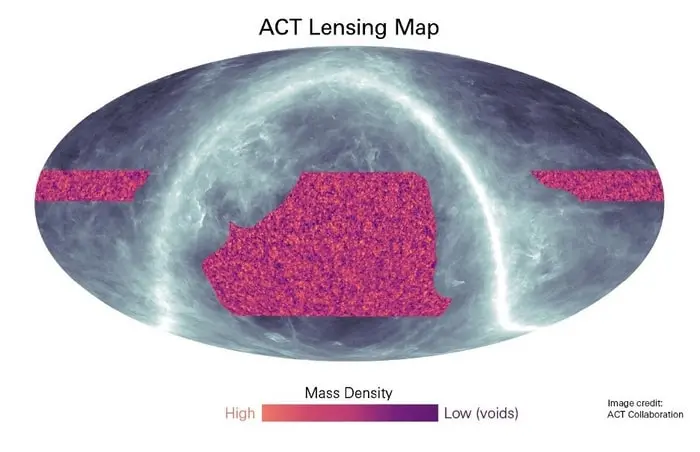For thousands of years, humans have been intrigued by the mysteries of the cosmos. Modern cosmology started in the early 1900s with the development of Albert Einstein’s general theory of relativity. It allowed cosmologists to understand the universe’s evolution and structure quantitatively.
Now, researchers from the Atacama Cosmology Telescope (ACT) collaboration has created an image that provides the most detailed map of dark matter distributed across a quarter of the entire sky.
This groundbreaking image extends deep into the cosmos and confirms Einstein’s theory of how massive structures grow and bend light over the entire 14-billion-year lifespan of the universe.
Map of the Invisible Dark Matter Across the Sky Reveals Features Predicted by Theories
Blake Sherwin, a professor of cosmology at the University of Cambridge, led a group of ACT researchers in mapping the invisible dark matter across the sky. The map shows features that are hundreds of millions of light-years across, and it looks just as our theories predict.

Dark Matter, the Elusive Component of the Universe
Dark matter makes up 85% of the universe. Yet it has been hard to detect because it doesn’t interact with light or other forms of electromagnetic radiation. As far as we know, dark matter only interacts with gravity.
Observing the Dawn of the Universe’s Formation
To track down dark matter, a team of more than 160 collaborators participated. Building and gathering data from the National Science Foundation’s Atacama Cosmology Telescope in the high Chilean Andes. They observed light emanating following the dawn of the universe’s formation, the Big Bang.
Cosmologists often refer to this diffuse light that fills our entire universe as the “baby picture of the universe,”. But formally, it is known as cosmic microwave background radiation (CMB).
How Gravitational Pull Warps CMB
The team tracked how the gravitational pull of large, heavy structures, including dark matter, warps the CMB on its 14-billion-year journey to us, like how a magnifying glass bends light as it passes through its lens.
ACT’s Latest Results Confirm Einstein’s Theory of Gravity
The team’s latest results from ACT were able to precisely assess that the vast lumps seen in this image are the exact right size, providing new insights into an ongoing debate known as ‘The Crisis in Cosmology.’
Some recent measurements using a different background light, one emitted from stars in galaxies rather than the CMB, suggested that the dark matter was not lumpy enough under the standard model of cosmology and led to concerns that the model may be broken.
However, the team’s latest results confirmed that the vast lumps seen in this image are the exact right size.
CMB Lensing Data Rivals Conventional Surveys
“The CMB lensing data rivals more conventional surveys of the visible light from galaxies in their ability to trace the sum of what is out there,” says Suzanne Staggs, director of ACT and Henry DeWolf Smyth Professor of Physics at Princeton University.
“Together, the CMB lensing and the best optical surveys are clarifying the evolution of all the mass in the universe.”
ACT Decommissioned, but New Telescope is Slated to Begin Operations in 2024
ACT, which operated for 15 years, was decommissioned in September 2022. However, more papers presenting results from the final set of observations are expected to be submitted soon, and the Simons Observatory will conduct future observations at the same site, with a new telescope slated to begin operations in 2024.
This new instrument will be capable of mapping the sky almost 10 times faster than ACT.
Conclusion
In conclusion, the groundbreaking new image created by researchers from the Atacama Cosmology Telescope (ACT) collaboration is a significant milestone in the field of modern cosmology.
It confirms Einstein’s theory of how massive structures grow and bend light over the entire 14-billion-year lifespan of the universe. The image reveals the most detailed map of dark matter distributed across a quarter of the entire sky, extending deep into the cosmos, and provides new insights into an ongoing debate in cosmology.
Overall, the latest results from ACT are a testament to the brilliance of the theorists, the dedication of the more than 160 collaborators who have built and gathered data from the telescope, and the ingenuity of the new analysis techniques the team came up with.
The map is an awe-inspiring reminder of just how vast and mysterious our universe truly is, and how much we still have to learn about its origins and evolution.
Reference
New findings that map the universe’s cosmic growth support Einstein’s theory of gravity. (2023, April 11). Link to the source.
Atacama Cosmology Telescope. (n.d.). Atacama Cosmology Telescope. Link to the source.





